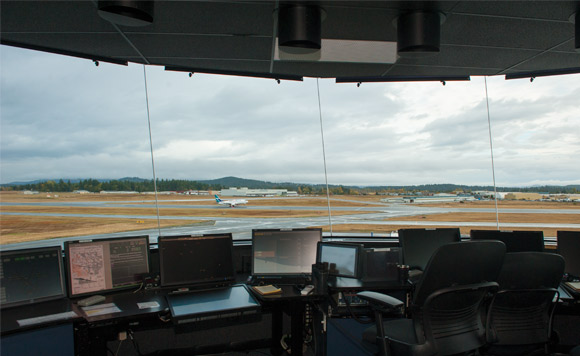by Paula Kully –
Driving along the Pat Bay Highway near Sidney, I am often thrilled at the sight of a plane suddenly swooping into my line of vision as it comes in for a landing at the Victoria International Airport. Or, how exciting is it to first hear the great whoop, whoop, whoop of a military helicopter before seeing it moving through the sky like a giant dragonfly? Some days, we may even be treated to a special viewing of an antique plane from bygone days – all because we have an airport right here on the Saanich Peninsula.
The Victoria International Airport, also known as YYJ, is the 10th-largest airport in the country and consistently wins awards for its outstanding customer service. During 2016, over 1.8 million passengers came through the airport while during the summer months this year, it served between 170,000 to 200,000 people per month.
Perhaps one of the most key components of the airport is the airport air traffic control tower and the people who work within it. Without them, aircraft could not navigate safely in and around the airport. They are responsible for approximately 400 to 500 aircraft per day during fall and winter months, and 700 to 800 per day during the busier summer months. Of these aircraft, 70% use visual flight rules, which means they are smaller aircraft where the pilot is able to see outside the cockpit to navigate. The other 30% are large or commercial aircraft such as Air Canada, Jazz, West Jet and so on.
The air traffic control tower at the Victoria Airport is owned and operated by NAV Canada, the not-for-profit company that provides air traffic control and other navigation services for the country. It is one of 41 towers and 55 flight service stations operated by NAV Canada located at different airports from Victoria to St. John’s. The tower at Victoria Airport operates 18 hours per day from 6 a.m. to midnight. Outside these hours, air traffic is managed by the Kamloops Flight Service Station. The tower’s team consists of 18 controllers and two supervisors who are managed by Darlene George, the Manager at YYJ for the past five-and-a-half years. Prior to that, she was an air traffic controller at the Langley Tower for 14 years and taught for three years. Darlene also manages the flight service station in Victoria’s Inner Harbour.
There are four positions at the Victoria Airport tower that work together to ensure aircraft can safely take off and land. The pilot’s first point of contact is the clearance delivery controller who provides the pilot with important information before they head down the runway such as confirming transponder codes. From there, the ground controller provides instructions for the pilot to taxi to the runway and the tower controller gives take off clearance and monitors the airspace around the airport for seven nautical miles. The outer controller monitors airspace outside this zone.
NAV Canada provides all their own training. Certification for controllers at YYJ takes between 10 to 12 months to complete whereas larger airports may require further training.
Air traffic controllers around the world must speak English to communicate as required by the International Civil Aviation Organization, but they also have their own extensive phraseology and acronyms that would seem like a foreign language to the untrained ear. A phonetic alphabetic and numerical system replaces letters and numbers with code words to minimize confusion and misunderstandings between air traffic controllers and pilots. For example, the letter “A” is “alpha,” “B” is “bravo” and “C” is “Charlie.” Instead of the number “nine,” the term “niner” is used.
We are fortunate to have the airport and its many resources and people within our community as they contribute to the economic diversity of our area by allowing goods and people to be transported here with ease and convenience.
The Airport Authority is also a wonderful community partner that has contributed to developing a positive lifestyle for residents through initiatives such as the well-used flight path where you will always find people walking, running and biking while they enjoy watching the air traffic overhead.




